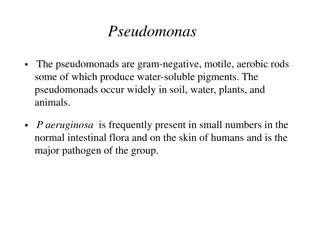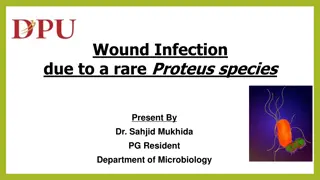Understanding Pseudomonas aeruginosa: Characteristics, Culture, and Pathogenicity
The genus Pseudomonas, specifically P. aeruginosa, is a well-known opportunistic pathogen found in diverse ecological niches. This bacterium, commonly associated with disease conditions in animals and humans, exhibits unique growth characteristics, pigment production, and virulence factors. Its adaptability and propensity for causing infections make it a significant concern in healthcare and veterinary settings.
Download Presentation

Please find below an Image/Link to download the presentation.
The content on the website is provided AS IS for your information and personal use only. It may not be sold, licensed, or shared on other websites without obtaining consent from the author. Download presentation by click this link. If you encounter any issues during the download, it is possible that the publisher has removed the file from their server.
E N D
Presentation Transcript
The genus Pseudomonas was Pseudomonadaceae Pseudomonas described more a century ago. nomenclatural creation of the genus Burkholderia. Both genera include aerobic, non-spore forming, oxidase positive , non-lactose ferrmentor, G- rods that grow on MacConkey agar. Genus Pseudomonas: Pseudomonas worldwide distribution. They are ubiquitous in soil, water, decaying organic matter & vegetation, but are opportunistic pathogens of animals, plants & humans. One species P. aeruginosa is commonly encountered as an animal pathogen, another species P. fluorescens is occasionally isolated from animal specimens. Recent lead arrangement to species have
P.aeruginosa is motile, G negative usually occurs as single or pairs. Culture: It is an obligate aerobe & can readily grow on many types of media. Some strains hemolyze blood. P.aeruginosa forms smooth round colonies with a fluorescent greenish color due to production of pyoverdin pigment. It may produce a non-fluorescent (pyocyanin). Some strains produce the dark red pigment pyorubin or pyomelanin. P.aeruginosa can colony types giving the impression of mixed bacteria growth. Thus it may have different biochemical & enzymatic activity & different antimicrobial susceptibility patterns. Culture from cystic fibrosis may yield P.aeruginosa that form mucoid colonies due to overproduction of alignate (exopolysacharride). Morphology & identification bluish pigment the black pigment produce multiple
Growth characteristics: P.aeruginosa grow well at 37-42 C. Growth at 42 C helps differentiate them from other pseudomonads. It is oxidase positive. Antigenic structure & toxins: Pili (Fembriae) extended from the cell surface & promote epithelial cells. Polysacharride responsible for the mucoid colonies in culture from patients with cystic fibrosis. The LPS is responsible for many properties of the organism. Most P.aeruginosa clinical infections produce enzymes including hemolysin & heat-labile phospholipase C& heat-stable glycolipid. P.aeruginosa produce exotoxin that causes tissue damage. Growth & antigenic structure attachment to host capsule is of the endotoxic isolated extracellular protease, from elastase, Many strains of
Unlike many environmental bacteria, pseudomonads have a remarkable capacity to adapt to & thrive in diverse ecological niches. P. aeruginosa & P. fluorescens have been found in a variety of aqueous solutions & on equipment, including mastitis preparations, semen extenders, irrigation fluids, antiseptics, hydrotherapy bath & endotracheal tubes. P. aeruginosa is found infrequently as normal flora of mucous membranes &GIT of healthy animals. The organism is an opportunistic pathogen because uncompromised tissues. associated disease conditions in animals are ovine fleecerot, bovine mastitis & abortion, equine metritis & corneal ulcer, canine otitis eexterna, embryo mortality botryomycosis, septicemia, infection, & abscesses in variety of animals. Disease & epidemiology it rarely P. infects aeruginosa in poultry, wound UTI,
Fleece rot of sheep is characterized by superficial inflammation economically important because of its downgrading of wool. Predisposing factors are prolonged wetting of the fleece & conditions of high humidity. Clinically the fleece is bluish green as result of production of the diffusible pigment pyocyanine. Older lesion develop a putrefactive odor that attract flies & may result in cutaneous myiasis. P.aeruginosa is a cause of bovine mastitis. The infection may be originated from the use of contaminated antibiotic intramammary infusion, dipping solutions or washing water. Infection can be acute, but usually chronic & resistant to treatment. In acute outbreaks, the animal may die due to endotoxemia. Chronic mastitis is characterized by low grade inflammation of the mammary gland with suclinical recurrence. Sporadic bovine metritis have been associated with P.aeruginosa . Cows & mares inseminated naturally or artificially with contaminated semen may develop varying degrees of RT disease. Disease & epidemiology of the skin. It is abortion & equine
P.aeruginosa is a common invader of the equine cornea. Infection usually follows Minor trauma. Loss of vision may occur if cases left untreated. Canine otitis P.aeruginosa is infrequent. If the infection untreated, P.aeruginosa underlying tissues, causing damage, otitis media or interna & osteomyelitis. P.aeruginosa is often recovered from dead poultry embryos. Severe disease outbreaks have followed egg injection with contaminated vaccines or egg dipping with antimicrobial solutions. Botryomycosis disease of the skin. Most recorded cases are caused by S. aureus, however, P.aeruginosa may also implicated in cattle, rodents & man. Trauma is an important predisposing factor for the inoculation of bacteria into tissues. In cattle lesions are reported on udder &nasopharynx. Disease & epidemiology externa caused by may invade cranial the nerve is a granulomatous
Disease & epidemiology P.aeruginosa Is an opportunistic pathogen of humans causing UTI, RTI, dermatitis, soft bacteremia, & variety infections. Infection is particularly a problem in patients with severe burns, cancer, AIDS immunocompromised conditions. P.flurescens disease in cattle, poultry & fish. The bacterium is an agent of environmentally acquired mastitis. mortality following dipping of eggs in contaminated disinfectant solutions. In fish, P.flurescens is associated with fin & tail rot & septicemia. tissue infections, systemic of & other causes sporadic Turkey embryo
P.aeruginosa is pathogenic only when introduced into areas devoid of normal defense e.g. damaged skin or mucous membrane, intravenous or urinary catheter or neutropenia (e.g. cancer patients). The bacteria attached to & colonize the mucous membrane or skin, invade locally & produce systemic disease. These processes are promoting by pili, enzymes & toxins. LPS play direct role in causing fever, shock, oligouria, leukopenia & disseminated intravascular coagulation respiratory distress syndrome. P.aeruginosa is resistant to many antimicrobials. P.aeruginosa is particular problem when isolated from surgical or maternity wards Pathogenesis (DIC) & adult considered as a
Specimens: skin lesion materials, pus, urine, blood, CSF, sputum & other materials. Smears stained with gram s stain revealed G negative bacilli. Culture: On blood agar & differential media commonly used for enteric G negative rods. P.aeruginosa is non-lactose fermentor. Culture is the specific test aeruginosa. P. aeruginosa is differentiated from P.flurescens by its grapelike odor, growth at 42 C, production of pyocyanin resistance to Kanamycin Laboratory diagnosis for diagnosis of P. pigment &























